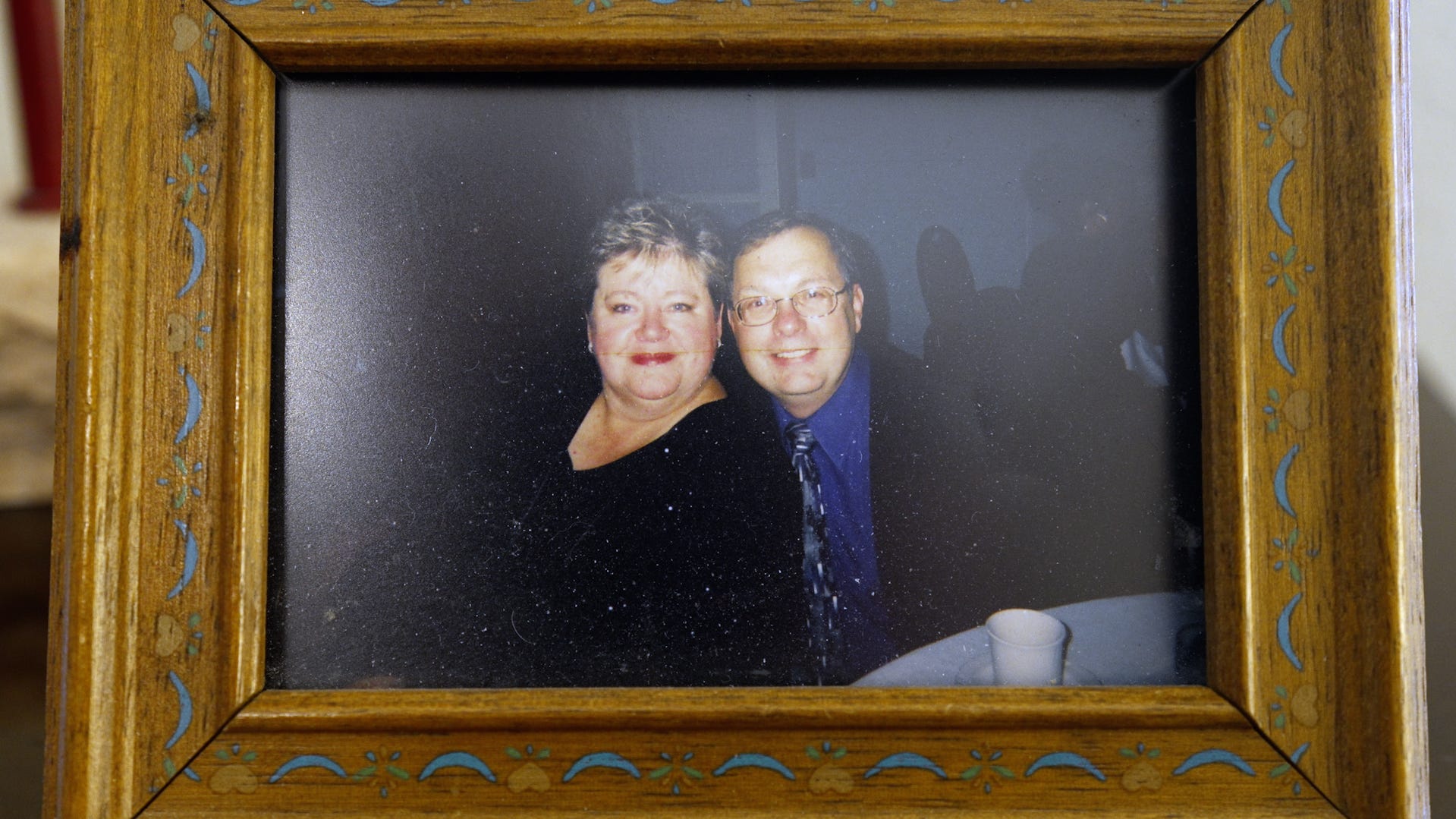
Handle with care: a caregiver’s story
Former caregiver David Cook reflects on the experience of caring for his dying wife and highlights the need for better help for other caregivers.
- Brittany Maynard chose medical aid in dying after being diagnosed with a terminal brain tumor.
- Maynard’s husband, Dan Diaz, became her caregiver and supported her decision to move to Oregon for access to the state’s Death with Dignity Act.
- Medical aid in dying, legal in 11 states and Washington, DC, allows terminally ill patients to take medication to end their lives peacefully.
- Experts emphasize the importance of open communication about death and end-of-life care.
Dan Diaz and his wife, Brittany Maynard, took their dogs Charley and Bella for a walk the morning of Nov. 1, 2014, with their friends and family. Later that day, Maynard died.
Doctors found Maynard’s brain tumor exactly 10 months prior, on New Year’s Day. The couple had been married a little over a year at the time.
“We were just a regular married couple,” Diaz, 53, said. “We’d go out for sushi on Friday nights.”
Within days of her cancer diagnosis, Maynard decided she wanted to move from California to Oregon to gain access to the state’s medical aid in dying program. Diaz followed her without question, knowing it was important to Maynard to die gracefully.
That fall, she started to suffer with pain that not even morphine could alleviate, Diaz said. She couldn’t sleep. Her symptoms included nausea, vomiting and seizures.
He remembers Maynard telling him: “Dan, I can feel it. I know that this cancer is killing me. I can feel that this is ending my life.”
Maynard died at the age of 29.
Death comes for everyone, yet talking about death is still taboo for many families. The topic can be particularly emotional for family caregivers who devote much of their lives to helping their loved one stay comfortable. However, not talking about the inevitable can make the logistics of dying more stressful than it needs to be, experts say, especially if there’s little time left.
Some patients find comfort in medical aid in dying, which allows individuals with six months or less to live the option to obtain a medicine that can help them die peacefully at a time of their choosing. It’s not considered euthanasia – which is when someone administers a lethal drug – because the patient takes the medicine themselves. Medical aid in dying is legal in 11 states and in Washington, DC.
“A lot of patients really express this desire to shield family members from the agony of watching them die, and potentially having them witness a really traumatic or a really burdensome death,” said Anita Hannig, an anthropologist and author of the book “The Day I Die: The Untold Story of Assisted Dying in America.”
Some caregivers say medical aid in dying helped in their grieving process, too.
Wrapped in Diaz’s arms and surrounded by her loved ones, Maynard took the medicine. Within five minutes, Diaz said, she fell into a peaceful sleep. Within 30 minutes, her breathing slowed and she died.
In the weeks leading up to her death, Maynard had captured the attention of millions as she shared her story and advocated for medical aid in dying to expand to more states. Her determination, Diaz said, also felt like a gift to him, by making his role plain and simple.
“All I had to do was just support her,” Diaz said.
How caregivers can support terminally ill patients who ask to die
Candace Dellacona, a family lawyer in New York who specializes in estates and trusts, knows how crucial it is to plan for a loved one’s death. But she said the concept has become “a lot more real” as she’s gotten older and seen her friends and family struggle to have those important conversations. She was a caregiver for her uncle in New York and helped with her father’s care, too, across state lines.
“I do this for a living, and I couldn’t say it to my uncle, like, ‘what do you want?’” Dellacona, 50, said. “What do you want your death to look like? What does that mean to you?”
Many people say they want to stay at home at the end of their lives. When Dellacona hears this, she asks her clients: “How? Do you want 24-hour care? Like, let’s get into the nitty-gritty. Those are the things that people are not talking about.”
When a patient asks to die or wants more information on medical aid in dying, Hannig said, it can be jarring for their families.
“It’s not necessarily about the request itself, but what the request symbolizes,” she said.
Some family members come on board immediately, especially if they’re intimately aware of the patient’s suffering. Patients who want to access medical aid in dying need the support of their family caregivers, Hannig said, in order to get to appointments, fill out paperwork and get the prescription, not to mention moral support.
When families don’t offer that support, she said, it’s often because they are in denial about their loved one’s condition. Caregivers might be angry because they aren’t ready for their loved one to die.
Catie Kelley, policy counsel for Americans United for Life, an anti-abortion advocacy group that opposes medical aid in dying, said she feels compassion for these families. Everyone has the right to withdraw life-sustaining care, Kelley said. However, she takes issue with patients speeding up the process.
As a previous prosecutor of health care fraud, Kelley said she’s worried about patient safety and ensuring patients aren’t manipulated by their caregivers. She’s concerned that laws allowing medical aid in dying don’t provide enough safeguards for patients, such as comprehensive mental health evaluations.
People who opt for medical aid in dying are not suicidal, Hannig, the anthropologist, said. Terms like “physician-assisted suicide” and “euthanasia” are often used by opponents to medical aid in dying, though the terms aren’t totally accurate.
Jessica Empeño, national director for clinical engagement at Compassion & Choices, a nonprofit advocacy group that supports medical aid in dying, said the biggest difference between medical aid in dying and a phrase like “physician-assisted suicide” is that in medical aid in dying, the patient is in control. A physician doesn’t even have to be in the room when a patient takes the medicine.
Most importantly, Empeño said, these patients don’t want to die, “but they are dying.” It’s a long and involved process to apply for and get the medication, and only patients with a prognosis of six months or less to live qualify.
One thing Empeño, Kelley and Hannig agree on: When a patient asks to die, it’s crucial to ask questions about their pain levels, comfort and mental health.
Caregiving is ‘the best way I can say I love you.’
Death isn’t a taboo subject in all families. Jacob Shannon, 47, said death and medical aid in dying were normal topics of conversation in his family, where his mom worked in public health and his stepfather was a doctor turned health care executive.
His mother, Lynda Shannon Bluestein, was a long-time medical aid in dying advocate and sued Vermont to remove its residency restriction on the program because Connecticut, where she lived, didn’t allow medical aid in dying. She won, and died in Vermont in 2024 after her cancer came back. Oregon is the only other jurisdiction without a residency requirement.
On his way home from his first visit to his mother after her remission ended, Shannon said he remembers thinking: “I shouldn’t be here. Why am I in the car? I need to be with my mom. I need to take care of her.”
He left his home and family in Colorado and spent the rest of his mother’s life caring for her.
“I really believe that caring for the people that I love when they need the most help is the best way I can say I love you,” he said.
Open communication is key to caregiving and preparing for a loved one’s death, Shannon said. “Have the hard conversations,” he said, and be ready to help in every way: cooking, cleaning, laundry, errands and more.
“Taking care of a loved one at the end isn’t just, you know, by their bedside,” Shannon added. “It’s taking care of life. And don’t be scared, jump into it. Just help.”
‘Have the conversation.’
Not every patient can or wants to move to one of the 12 jurisdictions that allow medical aid in dying. Moving can be expensive, and some patients don’t have the physical ability or time to move.
The best thing caregivers can do, Empeño said, is to advocate for their loved one and plan for their death. Ask questions about what the patient wants when they are dying, like if they want visitors in those final moments and who should make final decisions if the patient can’t themselves.
In the end, Dellacona said, her clients who talk about death feel more empowered and at peace.
“It’s just really helpful to have the conversation and talk openly to plan for end of life,” Empeño said. “That is something we can’t underestimate the value of enough.”
As Maynard’s caregiver, Diaz said he was constantly researching, asking questions and reaching out to clinical trials that rejected his dying wife. He took a leave of absence from work. He helped her with her more than a dozen medications, went through medical bills while she was asleep and tried to take things one day at a time. Caregiving, he said, is “doing everything you can just so that they can have a good day.”
Because they’d talked about her death and Maynard was the one “calling the shots,” he said, Diaz doesn’t have any regrets or feel guilt with his grief. Now, Diaz advocates for medical aid in dying full time, keeping a promise he made to his late wife.
“She died in the same way that she lived her life, with grace, compassion and love.”
Madeline Mitchell’s role covering women and the caregiving economy at USA TODAY is supported by a partnership with Pivotal Ventures and Journalism Funding Partners. Funders do not provide editorial input. Reach Madeline at memitchell@usatoday.com and @maddiemitch_ on X.







онлайн оценка дорогих часов http://ocenka-chasov-onlajn3.ru/ .
где взять кредит с плохой кредитной историей http://perekop.info/preimushhestva-lgotnoj-ipoteki-kak-vospolzovatsya-vygodnymi-usloviyami// .
Промо-акции на украшения для праздников, сможете заказать прямо сейчас.
Шары на выписку из роддома http://www.shariki-shop47.ru/ .
масляный трансформатор купить http://www.silovye-transformatory-kupit3.ru .
Эксклюзивные изделия: императорский фарфор с авторским оформлением
ифз купить https://imperatorskiy-farfor.kesug.com .